In the Hindu legend of the Churning of the Milky Ocean, the gods and the demons churned the Milky Ocean in order to acquire the Nectar of Immortality. In this grand spectacle, Vishnu, the preserver of the cosmic order, had taken the form of a massive tortoise (Kurma Avatar) in the middle of the Milky Ocean. His humped shell acted as a pivot for Mount Mandara or Mount Meru, which served as the churning stick, while the serpent Vasuki was the cord for the churn.
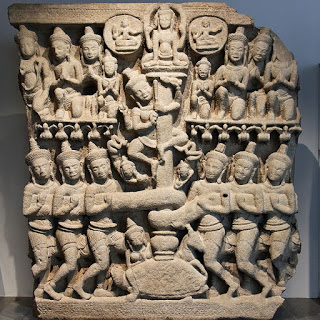
This legend may have been known to the civilizations of Mesoamerica as well, for in the Museum of Anthropology in Mexico City, I saw a carving of a turtle supporting a pillar on its back, looking breathtakingly similar to the depiction of Vishnu as a turtle supporting Mount Meru.
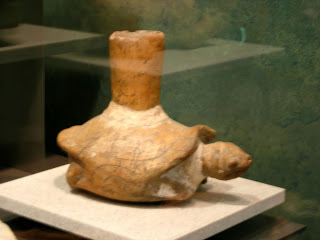
Now, it is well-known that the people of Mesoamerica venerated turtles, just as in Asia, where the turtle is a sacred animal and even worshipped in temples. The Mayan had a concept of a double-headed turtle god whose image can be found carved on many Late Classic altars. The double-headed turtle was called the great Divine Lord, who had appeared at the dawn of creation. A Mayan inscription states:
“On 4Ahaw 8 Kumk’u,
was seen the first image of the Turtle,
the great Divine Lord”.
It was from the cracked shell of this double-headed turtle that the Maya Maize God emerged. The Maize God, who is the source of fertility and abundance, is also the central World Tree, an axial symbol equivalent to the Mount Meru.
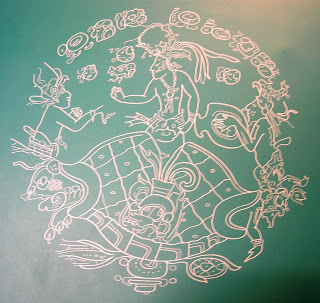
I was really surprised, however, when I came across the work of independent researcher Carl de Borhegyi, who has pointed out in his online publication titled Soma in the Americas that the Churning of the Milky Ocean episode has been depicted in a number of Mesoamerican codices, murals and relief panels. For instance, a ball court relief panel from the archaeological site of El Tajin, in Veracruz Mexico, depicts a turtle supporting the central axis, whose circular top can be seen. The churning mechanism used is an intertwined serpent, pulled at both ends by a pair of sky deities. All the key symbolic elements of the churning episode are present in this relief panel. It indicates that only did the cultures of Mesoamerica use very similar turtle symbolisms as those found in Asia, but they even drew from the same mythological tales.
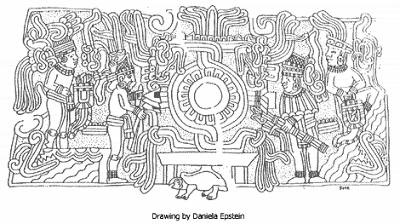
An interesting variant of the turtle symbolism can be seen in Chinese funerary architecture. It is a carved stone turtle called bixi, which serves as a base for holding memorial tablets that extol the virtues of the deceased.
Bixi turtles were generally placed at the beginning of the ornate spirit way that led to the tombs of Chinese emperors. They were also installed at the entrances of palaces, temples, and walled cities. Tortoise-mounted funerary stele can be found in many other Asian countries influenced by China such Mongolia, Japan, Vietnam and Korea. From a visual perspective, bixi turtles supporting memorial tablets on their back resemble the form of Vishnu as the cosmic turtle supporting the Mount Meru on his back.

At the Classic Period Maya city of Uxmal in Mexico I saw a stele which looks very much like a bixi turtle supporting a memorial tablet on its back – like those found in China and the other Asian countries. If we look closely we can make out the outlines of the eyes and mouth of the turtle. The turtle is placed at the bottom of a flight of stairs within the enclosure known as Nunnery Quadrangle, which corresponds to the placement of bixi turtles near the entrances to buildings and tombs.

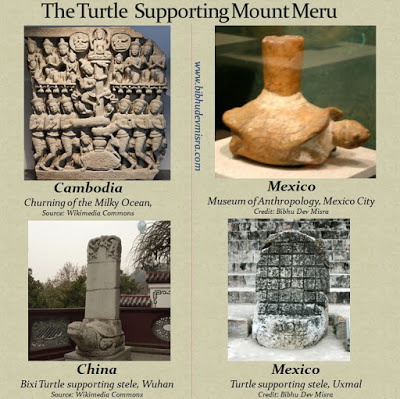
So, we find the same turtle symbolisms in the art and architecture of civilizations on either side of the Pacific. Even depictions of the Churning of the Milky Ocean, a quintessentially Hindu mythological tale, can be seen in the Mesoamerican codices, murals, and relief panels.
This implies that there must have been long-standing cultural contacts between the civilizations on either side of the Pacific. Betty Meggers, a research archaeologist at the Smithsonian Institution, believes that Asians have traveled to and from the Americas for thousands of years.
According to her, “Ancient man saw the ocean as a superhighway and not as a barrier.”
However, most American archaeologists continue to ignore the evidence for trans-pacific diffusion theories and view the Mesoamerican civilizations as an in-situ development. This dogmatic view is simply not tenable any longer. Modern archaeologists must revise their theories in accordance with the evidence, which strongly suggest Pre-Columbian Trans-Pacific contacts.
Author: Bibhu Dev Misra
Image Courtesy: Shutterstock
You may also like
-
India Can’t Afford to Remain Stagnant at this Juncture, Says PM Modi; Asks People to Buy Locally-Made Goods
-
Stolen Artefacts to be Returned to India from Scotland Museums
-
Legendary Singer Lata Mangeshkar Passes Away At the Age of 92
-
Netaji’s Hologram Statue at India Gate
-
10th Century Stone Idol of Goat Head Yogini IllegallyRemoved from A Temple in Lokhari, Banda, UP Being Returned to India
